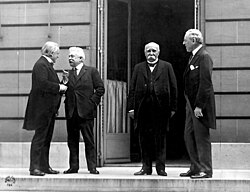

The Allied leaders of World War I were the political and military figures that fought for or supported the Allied Powers during World War I.
Contents
- Russian Empire
- French Third Republic
- British Empire
- United Kingdom
- Australia
- Dominion of Canada
- British Raj
- Union of South Africa
- Dominion of New Zealand
- Dominion of Newfoundland
- Kingdom of Serbia
- Kingdom of Montenegro
- Belgium
- Luxembourg
- Kingdom of Italy
- Kingdom of Romania
- United States
- Empire of Japan
- Republic of China
- Kingdom of Greece
- Kingdom of Hejaz
- First Portuguese Republic
- Kingdom of Siam
- Emirate of Nejd and Hasa
- First Brazilian Republic
- Notes
- References





